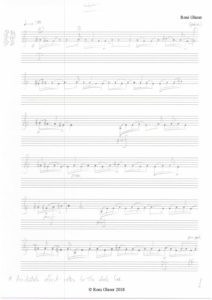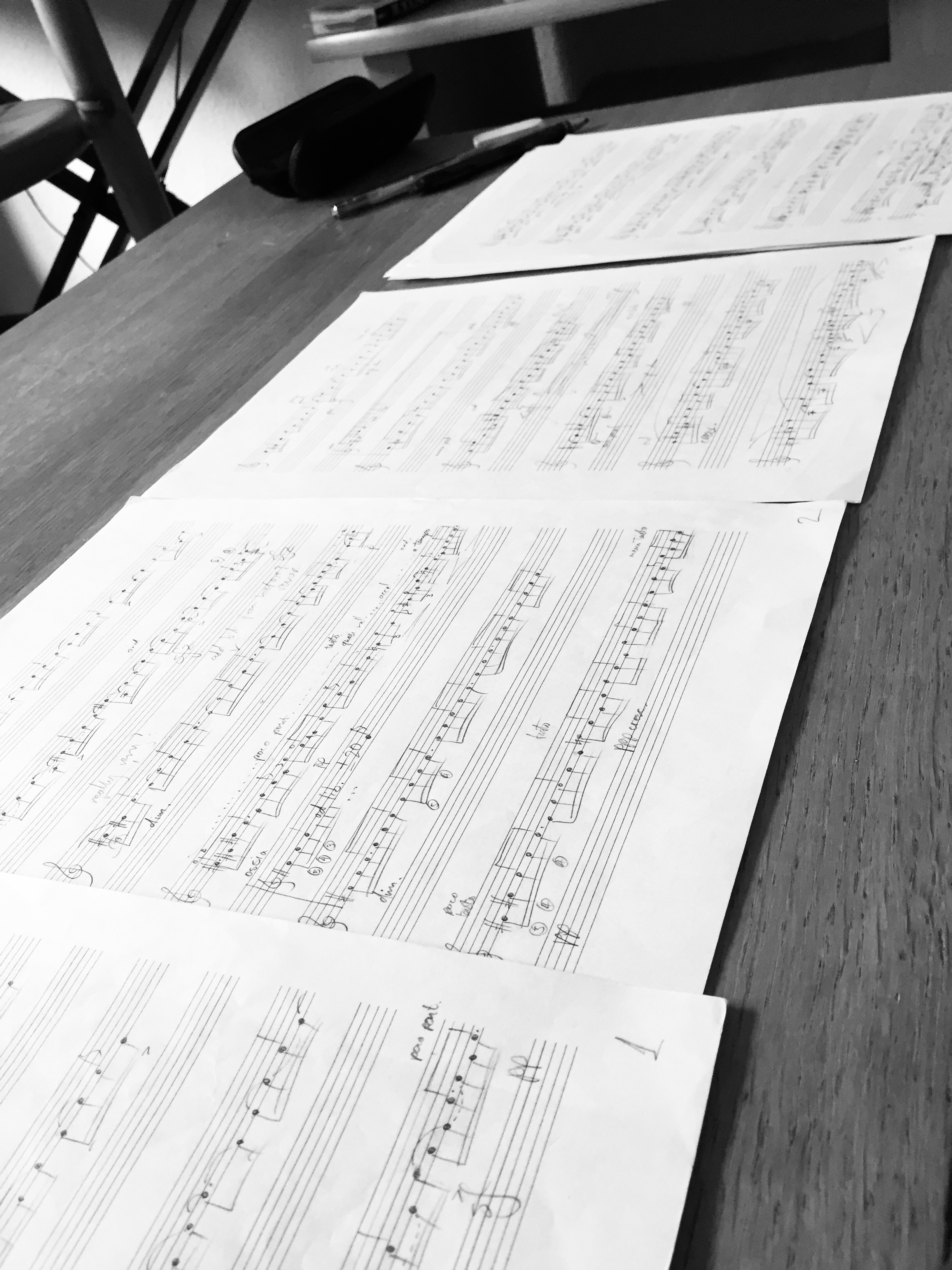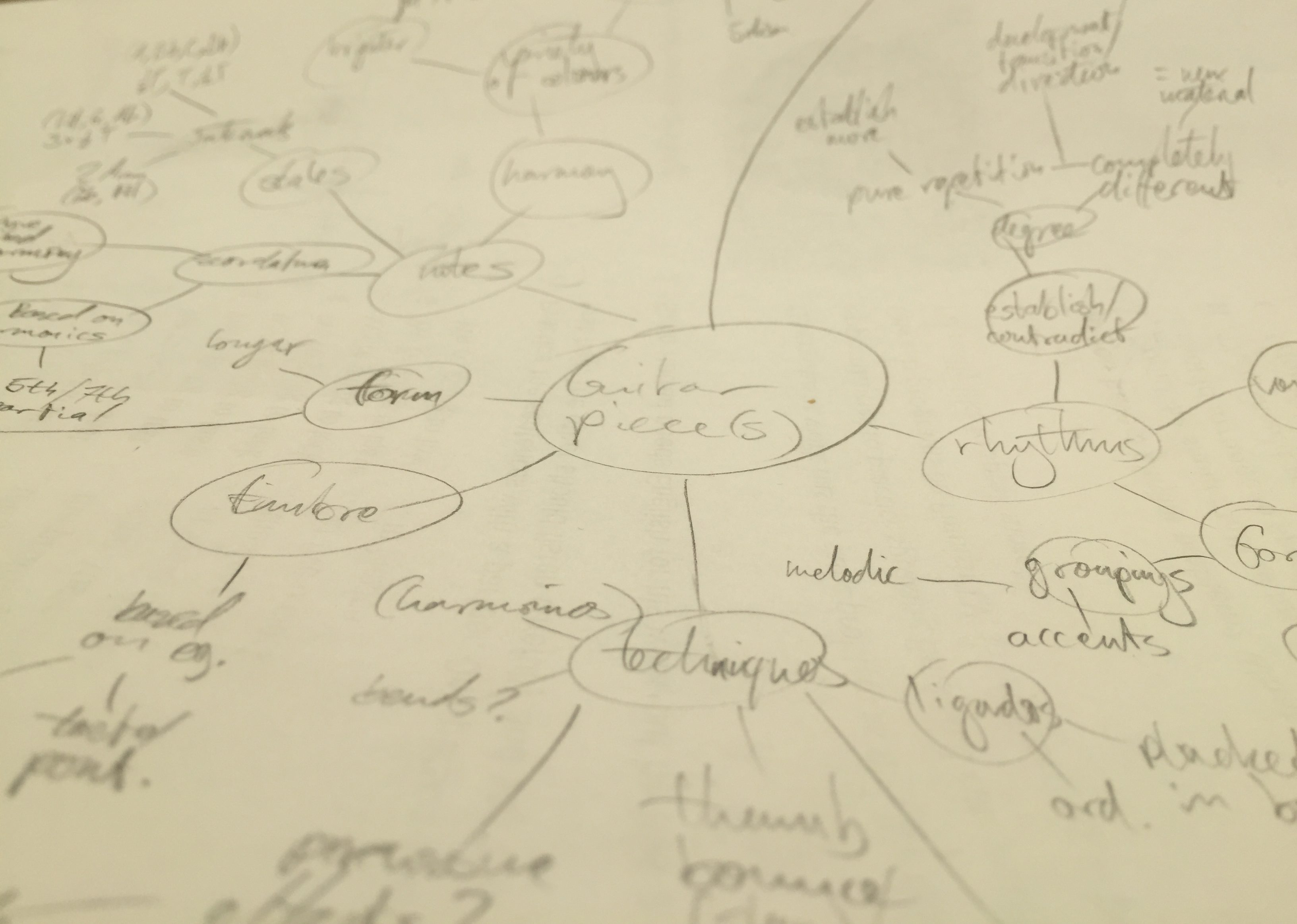Hello once again, and welcome back.
Notes on this week
Guitar
Since last week I’ve mostly been practising this second movement of the guitar piece I’ve been writing. I haven’t made enough progress since what I showed you last week for it to merit another video, but I’m a lot more secure with it, which is nice.
That’s the thing I like about practising, it works. Progress can vary, but you always notice a difference, however small.
I haven’t played or practised my own music this much before. The piece is within my capabilities but also challenging, plus I like it, so it’s fun and quite motivating, both in guitar playing and composition.
Composition
I haven’t quite had the occasion now that it’s Christmas to make much written progress in composing the other movements, but they continue to develop little by little in thought. I’ll hopefully be able to show you the beginnings at some point in the not too distant future.
Notes on the notes
After last week’s preview of what the guitar piece I’m writing sounds like, I’d like to show you some of its harmonic aspects. With respect to harmony, I’ll also discuss some thoughts on writing for the guitar, and what I see as the problem of flexibility of musical material. Lastly I’ll show you the tuning I’ve used, and how I’ve designed the melody.
It might get a bit technical, so let me know how you find it, and feel free to ask me anything.
Choosing notes
For this piece, I’ve chosen to use a harmonic and melodic scheme, i.e. how I’ve chosen the notes, that affords me a good deal of flexibility. There are reasons for this, so I’ll explain why and show you my solution.
The problem of flexibility
The guitar has all too often presented me with the problem of allowing me to write harmonies and counterpoint that sound fantastic to me and are wonderfully playable for a couple of bars, but alas, it rarely lasts. I try to take the idea further, develop it in some way, but the idea is too complex; the chords I’ve chosen are impossible to play in different positions, or I can’t play combinations of melodies in the configurations I want.
,This is obviously not the guitar’s fault, but the instrument can often handle a variety of textures and harmonies well, so it can be tempting to try and write things that just end up being too complicated. It’s somehow easy to forget that I’ve only got one left hand to fret the notes with. The onus is therefore on me as the composer to know the instrument and what works on it well enough to allow me to compose the music I want.
Solutions
Here’s what I’ve done in this piece to solve this problem.
Harmony
The harmony is essentially fairly simple, I just used intervals I wanted around open strings to define the sonority, mostly minor 2nds and 3rds, rather than particular chord schemes, to give me the freedom to make things technically a lot easier.
It often serves the function of providing more notes when the tension in the music requires it, and since the rhythm is very important here, it’s used for punctuating rhythmic accents, or at a climactic point.
The fingers dictate the harmony
The harmony I’ve used is very much dictated by what was comfortably available to my fingers and didn’t require much effort for me to play. I just worked with whatever notes were easy and comfortable to play, and if they didn’t sound too classical, that was enough.
I’ve heard a similar theory to describe flamenco harmony, such as when a barré (a technique which can requires a bit of effort for some) is left out of an F major chord, adding an extra augmented 4th and major 7th (the open B and E strings). The result is a very characteristic chord, and thus less effort equals better music. Hurray!
Open strings – tuning
I wanted to use certain intervals more than others in the harmony, so I used a scordatura of Eb (semitone lower) A D F# (semitone lower) Bb (semitone lower) E. If you don’t want to write in the classical harmony that the tuning was basically designed for, then it makes sense to change it.
I must admit I didn’t experiment all that much with it in terms of finding chord shapes and scales, I just chose some notes I liked and then started writing. The intervals were important in my choice though.
The two tritones between the top and bottom pairs of strings at an interval of a minor 9th are quite characteristic here, with the D a major 7th above the lowest note.
I like the mood the open strings have just by themselves. The three bass strings also sound pretty fat together. Have a listen:
The open strings are also very important notes in the grand scheme of things, especially the three basses. Why? On the one hand I could say that it’s because the harmonic scheme relates these pitches in the global structure of the music, the A largely functions as the tonal centre of the piece, with the Eb as a kind of Bartokian dominant, and the E#/F#, D as other tonal centres. But on the other, it’s because open strings are easy and don’t require much effort, and because they worked in ways that I liked at particular points in the piece. Basically I worked with what’s there, meaning what the guitar, as well as me, can do. Thus the musical material comes out of what’s there first, rather than imposing preexisting theoretical ideas.
Melodic scheme
Rather than a singable melody, I’m looking more for faster rhythmic movement, something towards spoken language. For me, this doesn’t mean there’s any sacrifice of expressiveness. I like the qualities of phrasing that can be found in the articulation of a minimal amount of notes, with sparing and careful use of certain notes.
Notes used
As before, flexibility through simplicity is key here. I’ve basically used groups of four notes, which are a minor second, major second and minor second apart, as in the first couple of pages: E# F# G# A, with a sort of base or tonic of E#/F#, tension with G#, and a climactic on the fourth note, A:

You can also hear me improvising with this in the video from a couple of weeks ago.
I obviously go beyond this four-note range and change it slightly. For example the major second in the middle becomes an augmented second. There are also a few runs, with one from the lower register to the top; to maintain the sonority I used a scale with a few rules:
- Never two whole tones in a row
- Never more than two semitones in a row
- About one augmented second (three semitones) per octave, always with a semitone on either side.
Phrasing the with minimal notes
I should mention that György Ligeti’s Musica ricercata II (as well as the analysis of my teacher Francisco Martín Quintero from when I studied in the conservatoire) was very important in guiding the phraseology of the first page, and how to use two just notes to good effect. I swear I didn’t choose the same E# and F# on purpose. Honest! They just fit nicely in relation to the open tuning and their position on the bass strings, and I like the slap of the strings against the fretboard with the hammer-on from the open string. Plus they’re two of my favourite notes.
Next Time
Right now it’s the holidays, so it’s difficult to predict what I’ll have been able to do by next time. Hopefully I can play you some more, show you some of the other movements, or even something else… Watch this space!
Comments and questions
As always, let me know if you have any comments or questions with the box below, or find me with one of the round icons right at the bottom of the page.





